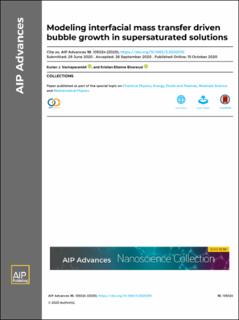| dc.contributor.author | Vachaparambil, Kurian J. | |
| dc.contributor.author | Einarsrud, Kristian Etienne | |
| dc.date.accessioned | 2020-10-19T07:42:28Z | |
| dc.date.available | 2020-10-19T07:42:28Z | |
| dc.date.created | 2020-10-16T09:53:30Z | |
| dc.date.issued | 2020 | |
| dc.identifier.citation | AIP Advances. 2020, 10 | en_US |
| dc.identifier.issn | 2158-3226 | |
| dc.identifier.uri | https://hdl.handle.net/11250/2683497 | |
| dc.description.abstract | A commonly encountered phenomenon in chemical processes is bubble evolution driven by supersaturation. On the continuum scale, this essentially involves interfacial mass transfer resulting in the growth of bubbles and their subsequent detachment from a surface. Analytical approaches to study this phenomenon typically involve estimating the driving force for interfacial mass transfer based on Sherwood number (Sh) correlations and the bulk concentration of dissolved gas. This is often not practical since the bulk concentration is often unknown and Sh correlations are sometimes not available to provide an accurate description of the associated flow fields. With the use of interface-resolved simulations to model these processes, the local distribution of dissolved gas can be obtained by solving for the concentration field. The driving force for interfacial mass transfer can be computed based on Sh correlations (which can be adopted for specific flows and are typically used in “engineering” applications) or the universally applicable Fick’s first law. This paper compares the predictions of these approaches for the well-studied case of a two-dimensional bubble growing in an unbounded supersaturated solution for three different levels of supersaturation. The equivalent two-dimensional simulations are run in a previously developed volume of fluid framework on OpenFOAM® [K. J. Vachaparambil and K. E. Einarsrud, Appl. Math. Model. 81, 690–710 (2020)]. The results show that the choice of an appropriate Sh correlation can provide a reasonable estimate of bubble growth. In a more universal approach, which is relevant when the flow being simulated cannot be captured by a single Sh correlation (e.g., bubble growth/coalescence and detachment) or when existing Sh correlations are not applicable, Fick’s first law can be used to compute the driving force for bubble growth, provided that the concentration boundary layer can be resolved. | en_US |
| dc.language.iso | eng | en_US |
| dc.publisher | AIP Publishing, American Institute of Physics | en_US |
| dc.relation.uri | https://aip.scitation.org/doi/full/10.1063/5.0020210 | |
| dc.rights | Navngivelse 4.0 Internasjonal | * |
| dc.rights.uri | http://creativecommons.org/licenses/by/4.0/deed.no | * |
| dc.title | Modeling interfacial mass transfer driven bubble growth in supersaturated solutions | en_US |
| dc.type | Peer reviewed | en_US |
| dc.type | Journal article | en_US |
| dc.description.version | publishedVersion | en_US |
| dc.source.volume | 10 | en_US |
| dc.source.journal | AIP Advances | en_US |
| dc.identifier.doi | 10.1063/5.0020210 | |
| dc.identifier.cristin | 1840066 | |
| dc.relation.project | Notur/NorStore: NN9741K | en_US |
| dc.description.localcode | © 2020 Author(s). All article content, except where otherwise noted, is licensed under a Creative Commons Attribution (CC BY) license (http://creativecommons.org/licenses/by/4.0/). | en_US |
| cristin.ispublished | true | |
| cristin.fulltext | original | |
| cristin.qualitycode | 1 | |

